#John Topsell
Explore tagged Tumblr posts
Text
When I was a little child, there was a particular library book I checked out week after week, endlessly renewing it as much as I was able. The book, How to Raise and Keep a Dragon by John Topsell was a quasi-nonfiction guide to, as you guessed, rearing different species of dragons. I loved it. Tiny-me had plans.
As an adult, I tried to buy it a few times. No dice. The book was so old that no mainstream bookseller stocked it. Even when I tried niche websites recommended by various booksellers and librarians, I still couldn't find it. It was sadly lost to time, apparently not popular enough to make it into the archives.
But.
My best friend had a copy of that book. We're going to call her G, for several reasons not relevant at the moment. I was discussing my search with G one day, for some reason I can't remember now. She got a funny look on her face, asked me a few questions about the cover, listened to me do a very poor job of explaining with my hands how the hardcover copy had included a real gemstone in the dragon's forehead, and then went off to fish it out of her bookcase.
I was Gobsmacked.
I should not have been, given that the history of shared childhood books between us both would have made a circle with ragged edges, more so than a venn diagram, but I digress. The book came home to live in my house for a few months, and I was delighted by the chance to read it again.
Do people remember those type of books? Dragonology, Egyptology, The Stone Age - a way of introducing children to non fiction. They very earnestly spoke about the responsibilities needed to raise dragons, the practicalities involved. There was a record of registration you could fill out, if you had carefully considered the information to your self and felt you were responsible enough to to go through with adopting a dragon.
I vaguely remember filling out some of the riddle and puzzle questions in the Dragonology books. I would never have written in John Topsell's book, it was a library book.
But.
When I re-read G's copy at home, smiling over the familiar artwork, I was surprised to turn the page and find the painstaking, somewhat-wonky handwriting staring back at at me. Baby G, with her name spelled out in freshly-joined but still-not-quite-got-the-hang-of-this-yet cursive lettering. Baby G had filled the registration out in her best handwriting, in glittery green gel pen to denote the importance of the document. This was compared to the earlier, less important checklists done in plain black ink.
I read the registration certificate. Smiled. Smiled some more at the names listed for G's dragon, her dam, and her sire - Eragon was also a great book. Go off, Christopher Paolini.
Breed; standard Western Dragon. The box 'miniture' was ticked, to show that G's dragon was of the minature specic variety, rather than a full size dragon. This was, as she would later explain to me, chosen on the basis that baby-G felt it was the more financially responsible choice. Also so she could keep her dragon in her house with her, but we're not there yet.
I looked at that certificate. Looked at it again. Looked at the calendar, and then looked at the sewing machine I had just been given for Christmas.
G celebrates her birthday in January.
The template came first. I studied the different images of the standard western dragon through the book, picked my favourite, and re-drew it to a significantly larger scale.
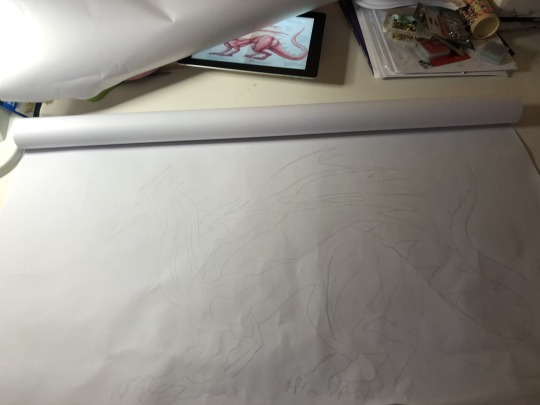
Inking the design to the fabric, four times over probably took the longest.
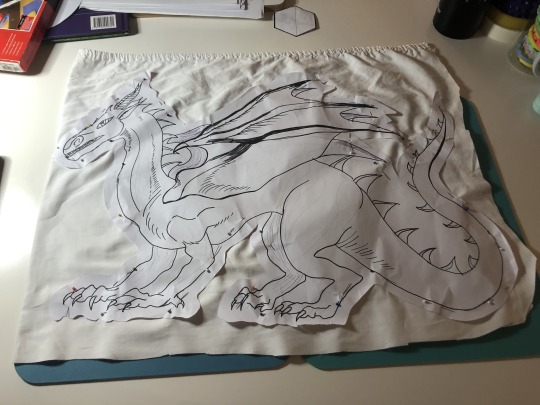
I very subtly asked G the next time she was over (after hurling all dragon-related materials in a panic into the depths of my wardrobe) what type of colour dragon she would have, should it come up. As G later said, that type of question from me truly did not register as anything other than a question asked from theoretical interest. I transitioned the topic as discreetly as I could after she answered, and delightfully, my sneakiness went in one ear, out the other, and she forgot I had ever asked until several weeks later.
I enjoyed painting them.


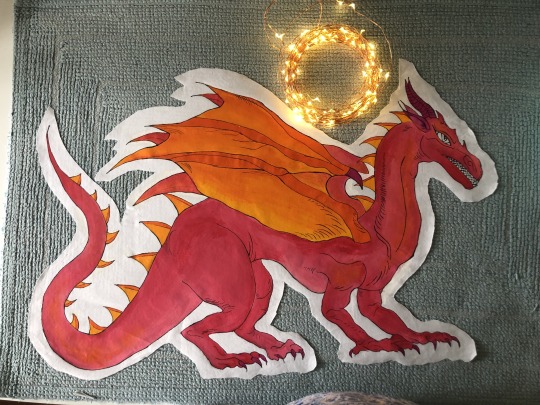
Don't ask me how many mistakes I made through this process. So many. I do already know how to sew, but it's been a long time. I'd been meaning to get back into it for a while.

Given that various aunts and grandmothers and my mother had a knack for calling when I was up to my elbows in either paint or pins, it became a family affair. Each of them peered at the project through face time and offered their advice.
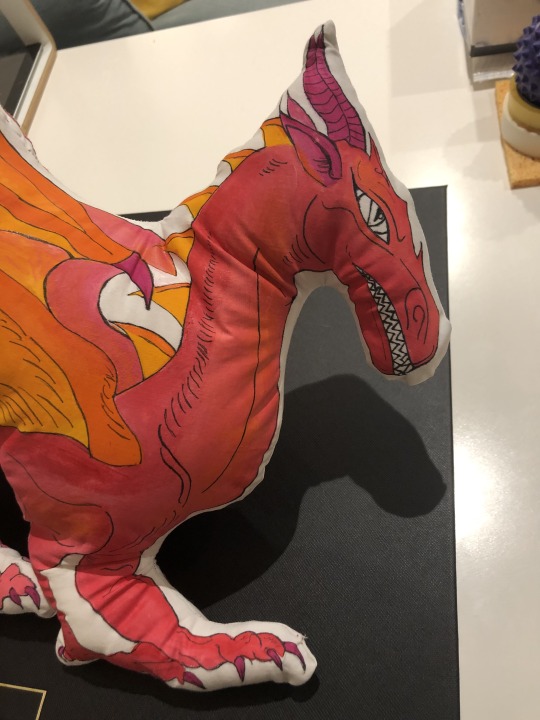
Some of the advice I took, some I didn't. No regrets about sewing it in pink thread. Considerable regrets about accidentally slicing one of the feet in half and having to fix that.
In the end though, she was finished.
I carefully pinned on her name tag, with the name baby-G had chosen with a little blue ribbon. A collar was unacceptable, this is a dragon, people, come on. Dragon's don't wear collars.
I put the book in the box, open to the registration certificate, and put the dragon on top. Wrapped the whole thing up with a bow and then refused to touch it before I sent myself mad trying to fix details that didn't really need to be fixed.
A bit late for her birthday, sure, but there we are. We'd gone for a trip off to nowhere for a weekend, to go try wine made out of blueberries and hike up a waterfall. (And climb on it. And swim in it. It was a very good waterfall).
I gave her the box, informed her she wasn't allowed to keep the box, just the contents (it was the only thing I had that was big enough for me to keep all of my A3 portfolios in, it had only been temporarily-repurposed as dragon housing), and then left the next bit up to the gods.
A surprise, sitting un-awaited for some 15 years in amber, to catch up to baby G and adult G together.
Happy Birthday, baby and adult G.

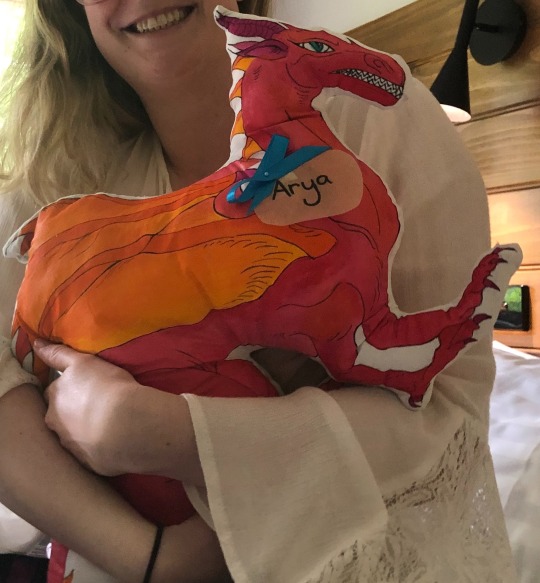
#StClaire speaks#How to Raise & Keep A Dragon#John Topsell#Joe Nigg#the thing about problems hammers and nails#except in this case it was childhood wishes and sewing machines#and as someone said#you were relearning to sew and you started with THAT?#well no#I started with a scrub hat#which kept the hair out of my face while I painted this#and then also that apron my aunt gave me the pieces to years ago that I refused point blank to do by hand#but yeah#101 mistakes later#and one re-attached foot#pretty happy with her#dragons
332 notes
·
View notes
Text
Legendary Creatures: Lamia

By John William Waterhouse - http://www.johnwilliamwaterhouse.com/pictures/lamia-1909/, Public Domain, https://commons.wikimedia.org/w/index.php?curid=1884661
The Lamia (Λάμια) is a ancient Greek mythological creature that started as a child-eater and then became a 'night haunting' spirit or diamon (a guiding spirit or 'lesser deity').

By Edward Topsell (c. 1572 – 1625) - http://info.lib.uh.edu/sca/digital/beast/pages.html?id=91, Public Domain, https://commons.wikimedia.org/w/index.php?curid=11694964
First written of as a Queen of Libya who had an affair with Zeus. When Hera found out about the affair, Hera stole Lamia's children, who were fathered by Zeus, from her through kidnapping or death and then cursed her with insomnia, perhaps making it so she couldn't close her eyes, so she couldn't escape her pain. Driven insane by her grief, Lamia sought out vengeance by eating any child she came across. Her appearance changed from being quite beautiful to monstrous. In an effort to offset Hera's actions, Zeus gave Lamia the gift of prophecy and the ability to remove and replace her eyes as a way to give her some peace.

By fonte, Public Domain, https://commons.wikimedia.org/w/index.php?curid=34791154
In the 1st Century BCE, Diadorus Siculus removed Zeus and Hera from the story, maintaining that Lamia was a Libyan queen, but saying instead that she ordered soldiers to steal children and kill them. Her actions then caused her to become ugly. He also said that she was born in a cave.

By Unknown author - Wall painting from the Odyssey Landscapes, Musei Vaticani, Biblioteca Apostolica, Città del Vaticano, Rome., Public Domain, https://commons.wikimedia.org/w/index.php?curid=13309598
Some sources state that Zeus took Lamia to Italy, to the city of Lamos, for their affair, where the Laestrygonians, which were man-eating giants, came from. Others say that she was the queen of the Laestrygonians.

Original image by Marie-Lan Nguyen. Uploaded by Mark Cartwright, published on 11 January 2017. The copyright holder has published this content under the following license: Public Domain
Like many monsters, the Lamia was used as a bogeyman to keep children in line, as Diadorus recorded in the 1st century BCE. Quintus Horatius Flaccus, commonly known as Horace, who lived from 65 BCE-8 BCE, wrote against being too fantastical, giving the example of '[nor should a story] draw a live boy out of the Lamia's belly'. Lamia was held in company with the Gorgons and others as 'mormo' ('female spirits invoked by mothers and nurses to frighten children').

By Isobel Lilian Gloag - http://24.media.tumblr.com/tumblr_lbqq4kGf961qzs3iqo1_500.jpg, Public Domain, https://commons.wikimedia.org/w/index.php?curid=15045311
By the 1st century CE, Lamia became a seductress, luring young men to devour them, with Lucius Flavius Philostratus, known as Philostratus or 'the Athenian', who lived from about 170-240 CE., writing that a student of Apollonius was seduced by 'one of the empousai (a shape-shifting female with a copper leg), whic most other people would call lamial or mormolykeia'. Apollonius also said 'you are warming a snake (ophis) on your bosom, and it is a snake that warms you', which gave rise to the idea that Lamia became snakes.
2 notes
·
View notes
Note
What's your review of the tarasque from one of my childhood dragon books? (Joseph Nigg, John Topsell: How to Raise and Keep a Dragon)

This guy was always one of my favourites from this book. So chunky and unique-looking. Thanks for reminding me it exists :D
FANTASTIC Beast 10/10 I desperately want to be friends with it
1 note
·
View note
Text
Every time I’m like “dragon books, you know, like Dragonology and Dracopedia” I need to just slide in somewhere “...and How To Raise And Keep A Dragon” (by Joe Nigg/John Topsell) because that book is also an excellent member of the “what if dragons from mythology were real?” genre. However my copy of it is in German (simply called ‘Drachen’) so due to my mediocre German reading skills I might be missing out on some of the details of the text. (also thanks Spire for this book it is a treasure).
It’s not a series of books like Dragonology or Dracopedia, it’s just 1 volume, but that volume contains details on: asian dragons, cockatrices, indian dragons, drakons, joppa dragons, multiheaded dragons, mushussu, piasa, rainbow serpents, salamanders, sea dragons, standard western dragons, the tarasque and worms.
I’m starting to write and queue book reviews for this blog, but I just thought I would give a shoutout to this book because it often gets hidden behind Dragonology and Dracopedia, probably because I don’t know the text as well due to my Englishness.
8 notes
·
View notes
Link
I just added this listing on Poshmark: How to Raise and Keep a Dragon by John Topsell.
0 notes
Photo

Top Sellers of Week 3, September 2019 1. Green Day - https://www.bighit.com/green-day-tickets 2. Trans-Siberian Orchestra - https://www.bighit.com/trans-siberian-orchestra-tickets 3. Elton John - https://www.bighit.com/elton-john-tickets 4. NFL - https://www.bighit.com/sports/football/nfl-football-tickets 5. Hamilton - https://www.bighit.com/hamilton-tickets #TopSellers #BigHit #BigHitTickets #GreenDay #TSO #TransSiberianOrchestra #NFL #EltonJohn #Hamilton https://www.instagram.com/p/B2pFY1tlEj5/?igshid=9ihplv2fz3cw
0 notes
Text










The rest of it. Looked up the name John Topsell who wrote a book i was obsessed with called how to raise and keep a dragon

Choice material found in an old book i had
1K notes
·
View notes
Video
tumblr
Завтрак у малышки и другие весёлые кадры.
На следующей неделе страничка из за отсутствия финансирования полностью будет закрыта. Страничка существует только благодаря финансовой поддержки читателя. Покупайте товары в предлагаемых интернет магазинах и тем самым поддерживайте мой блог или можно сделать перевод на карту сбербанка. Номер карты: 4817 7600 2236 5005 Спасибо за поддержку!
С меня инфа с вас ПОДПИСКА!!!!!(подписались? Молодцы! вот и договорились)
Куртка John & Yoko и другая европейская одежда: [url]https://f.gdeslon.ru/f/3c35a7707b09eb14[/url]
Шуба из норки с воротником, отделка соболь: [url]https://f.gdeslon.ru/f/8b4ba17e3ab0fac2[/url]
Комбинезон утепленный и другая модная одежда для всей семьи: [url]https://f.gdeslon.ru/f/42b2265e5f1cb9aa[/url]
Недорогие приключения по России и всему остальному миру: [url]https://f.gdeslon.ru/f/10b76ac9193b668e[/url]
Туры, путешествия, экскурсии, бронирование гостинниц, жд билетов, билетов автобусов, электричек и авиа билетов. Всё это вы найдёте на одном онлайн сайте: [url]https://f.gdeslon.ru/f/0bf670fefac991fe[/url]
Экстремальные путешествия и отдых по всему миру. Это восхождения на вулканы, школы альпинизма для детей и взрослых, конные экспедиции, сплав по рекам, путешествие в антарктиду, пешие прогулки и походы, сафари в национальных парках, снегоходные экспидиции и ски-туры, тур на джипах, фрирайд, фото тур. А подобрать путешествие по всему миру и узнать дату его проведения вам поможет интернет магазин: [url]https://f.gdeslon.ru/f/5cae6fed18ccd640[/url]
Футболки с красивыми котиками и много других товаров в онлайн гипермаркете: [url]https://f.gdeslon.ru/f/966f0690dcb9cd31[/url]
Школьная одежда и другая детская одежда: https://f.gdeslon.ru/f/90039b159e8945c5
Красивое платье TopSeller и много других товаров в мегамаркете: https://f.gdeslon.ru/f/21ec8bbc40b0303a
Круизы на теплоходах и кругосветные круизы на океанических лайнерах, горящие туры по странам мира вам предоставит интернет компания: [url]https://vk.com/public110633011?w=wall-110633011_1260[/url]
0 notes
Photo
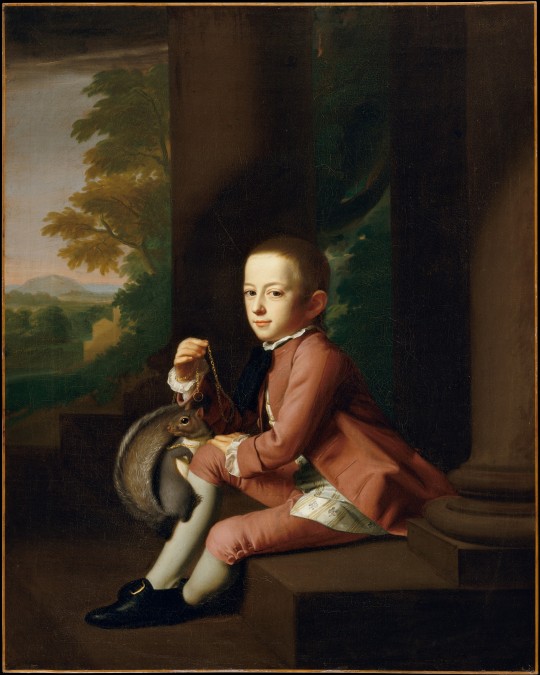
John Singleton Copley, Daniel Crommelin Verplanck, 1771
http://www.metmuseum.org/art/collection/search/10522
Daniel Crommelin Verplanck (1762–1834) was born in New York and spent the early part of his life in the family home on lower Wall Street. He was the eldest son of Judith Crommelin and Samuel Verplanck (39.173). While attending Columbia College (formerly King's College), he married Elizabeth Johnson, daughter of the president of Columbia. They had two children. Following her death in 1789, Verplanck married Ann Walton, with whom he had seven children. They lived on Wall Street until 1803 and then moved to Fishkill-on-Hudson, New York. He represented Dutchess County in Congress from 1803 until 1809. The portrait was painted in 1771 when Daniel was nine years old. The background has traditionally been identified as a view from the Verplanck country house at Fishkill, looking toward Mount Gulian.
https://outofthiscentury.wordpress.com/2010/02/03/wild-colonial-american-pets/ -
According to numerous sources, squirrels were among the most desirable and entertaining pets, and, if caught young enough, easy to tame. People frequently raided squirrel nests for their young, and the babies were sold in the city markets. Their popularity is attested to by numerous period paintings which show leashed, collared squirrels perched near (or sometimes on) their young owners. As one visitor remarked in 1748, “The gray and flying squirrels are so tamed by the boys that they sit on their shoulders and follow them everywhere.” Another writer, Edward Topsell, described squirrels as “sweet sportful beasts and…very pleasant playfellows in a house,” despite their predilection for chewing up their owner’s woolen garments. Since they could easily chew their way through wood, special tin cages were developed, possessing metal bars sturdy enough to house them. When someone discovered that squirrels would run on an exercise wheel, colonial tinsmiths began making amusing cages in the forms of mills with waterwheels.
1 note
·
View note
Text
What Is The Origin Of (141)?...
What Is The Origin Of (141)?…

Crocodile tears When we weep crocodile tears we are said to be putting on an insincere show of grief. But why crocodiles? And do they really weep? The idea that a crocodile weeps insincerely has a long pedigree. It was thought that crocodiles, while they were luring and devouring their prey, shed tears. As far back as classical times, a collection of proverbs attributed to Plutarch compares…
View On WordPress
#Bogorad syndrome#crocodile as symbol of hypocrisy#crocodile tears syndrome#Edward Topsell#F A Bogorad#Just So Stories#origin of crocodile tears#Photios#Rudyard Kipling#Sir John Mandeville#William Shakespeare
0 notes
Photo
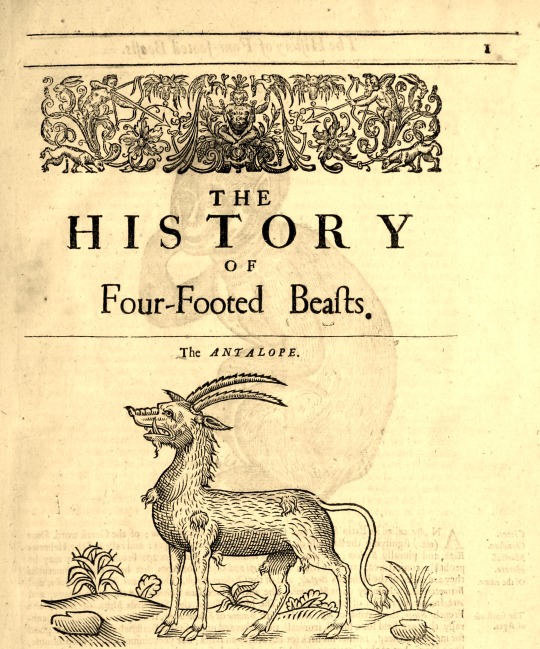



The history of four-footed beasts and serpents,
By Topsell, Edward, 1572-1625 Gessner, Conrad, 1516-1565 Moffett, Thomas, 1553-1604 Rowland, John, M.D.
Publication info London,Printed by E. Cotes, for G. Sawbridge [etc.]1658. Contributor: Duke University Libraries (archive.org BHL Collections: Monsters Are Real
99 notes
·
View notes
Text
Hyperallergic: The Biodiversity of the World Captured in Five Centuries of Animal Art
“Bengal tiger,” watercolor by a Calcutta artist (1820) (Hastings Albums, courtesy British Library)
A Bengal tiger does not travel well, and especially didn’t in the centuries before sedation and airplanes. But 19th-century scientists in England could study its stripes from afar thanks to the international trade of art, long a vital medium for scientific understanding. The Paper Zoo: 500 Years of Animals in Art by science historian Charlotte Sleigh, out March 8 from the University of Chicago Press, is a lushly illustrated publication with 250 images from the British Library chronicling how scientific art has expressed biodiversity over the centuries.
Cover of The Paper Zoo (courtesy University of Chicago Press)
It has not always been kind. Sleigh notes that the original text for an illustration of a horned frog in George Shaw’s The Naturalist’s Miscellany (1789–1813) read: “Should inquiry be made, which is the ugliest animal yet known to exist? The creature here represented might perhaps with justice be proposed as an answer: an animal of such prodigious deformity as even to exceed in this respect the Surinam toad, or Rana Pipa.”
Sleigh divides her book into four sections: exotic, native, domestic, and paradoxical. That last is particularly colorful, filled with anecdotes about completely imaginary creatures that were assembled due to mangled word-of-mouth descriptions, and sometimes supported by enterprising individuals. “Cashing in on the craze for natural-historical collections in the early modern period, canny sailors and inhabitants of far-flung lands stitched together body parts to make salable, ‘real’ monsters,” Sleigh writes. Along with unicorns and mermaids, there is the more fantastic and terrifying “manticore” in Edward Topsell’s 1658 The History of Four-footed Beasts and Serpents. The lion-like animal has the face of a man, with three rows of grinning teeth.
Sleigh explains that “animals began to appear in medieval works of art,” often as biblical Lambs of God or one of the symbols of the evangelists (an ox, lion, or eagle). As printing developed and became widespread, animals of varying accuracy flourished in books, whether in the form of early woodcuts or later engravings. A well-depicted exotic animal was the intellectual’s prize.
Pages from The Paper Zoo (photo by the author for Hyperallergic)
Pages from The Paper Zoo (photo by the author for Hyperallergic)
“Dürer mostly produced his animal images in watercolour, and such objects, like the pictures in the collection of the Lincei, were valuable items for exchange between wealthy savants around Europe,” Sleigh writes. “In Restoration London, a painting of a lizard on vellum could command higher prices than portraits in oil executed by even the most fashionable painters.”
Naturally, there were the overachievers, including John James Audubon, who put a vibrant, life-size aviary on paper with his 19th-century Birds of America. The Paper Zoo also has glimpses of incredible naturalist voyages like those of Maria Sibylla Merian, who in 1699 set out for South America to illustrate its insects, and Ernest Haeckel, who in the 19th century created detailed drawings of microscopic animals. They had a major influence on the fluid shapes of Art Nouveau.
High-speed and high-definition photography eventually took over as a way of visually capturing wildlife in the 21st century. Still, some extinct animals like the dodo or great auk mainly survive through old illustrations. Often, though, the creator’s name is lost. “Artists are not always acknowledged — and there is even more rarely a sound grasp of the different roles played by drawers, engraves, and colourists,” Sleigh states. Below are selections from The Paper Zoo, recalling the sometimes anonymous artist’s role in five centuries of shared scientific knowledge.
Johannes Jonstonus, Historiae naturalis de insectis (Frankfurt am Main, 1650–30), illustrations by Matthäus Merian. From The Paper Zoo: “The engraver and publisher Matthäus Merian the elder was the father of Maria Sybilla Merian, although he died when she was very young. He was apparently less committed to life-drawing than his daughter, producing visual descriptions of no fewer than eight separate species of unicorn.” (courtesy the British Library)
“Purple-bellied Lory (Lorius hypoinochrous),” original watercolor, later engraved as plate 170 in George Edwards, A Natural History of Uncommon Birds, and of Some Other Rare and Undescribed Animals (London, 1743–51) (courtesy the British Library)
“Horned frog,” from George Shaw, The Naturalist’s Miscellany (London, 1789–1813). The original text with the picture asked: “Should inquiry be made, which is the ugliest animal yet known to exist? The creature here represented might perhaps with justice be proposed as an answer: an animal of such prodigious deformity as even to exceed in this respect the Surinam toad, or Rana Pipa.” (courtesy British Library)
“King penguin,” from George Shaw, Musei Leveriani explicatio Anglica et Latina (containing select specimens from the museum of the late Sir Ashton Lever, Kt., with descriptions in Latin and English) (London, 1792) (courtesy British Library)
“1. The four horned Ram, 2. Horns of the Iceland Sheep, 3. Horns of the Cretan Sheep,” from Ebenezer Sibly, An Universal System of Natural History Including the Natural History of Man, etc. (London, 1794–1807) (courtesy British Library)
“Red-bellied snake,” from George Shaw, Zoology of New Holland, the first book of Australian animals (London, 1794) (courtesy British Library)
“Ring-tailed lemur,” from George Edwards, A Natural History of Uncommon Birds, and of Some Other Rare and Undescribed Animals (London, 1743–51). From The Paper Zoo: “This picture summons up the myth of the Fall: the contemplated fruit, the lurking partner, the curling, striped, snake-like tail. There is even a banished creature disappearing off stage-left. Edwards kept a ‘Maucauco’ (as the lemur was also known) alive for a while in his home, finding it a ‘very innocent, harmless Creature, having nothing of the Cunning or Malice of the Monkey-Kind.’” (courtesy the British Library)
“Octopus,” from George Shaw, The Naturalist’s Miscellany (London, 1789–1813). From The Paper Zoo: “The ocean is understandably a source of terror, and tales of giant squid or octopuses are one way of making such fears manifest. In 1802, the French naturalist Pierre Denys de Montfort posited the existence of two such species. This example from a British book of the same era is truly the stuff of nightmares, coyly curled onto the page, but threatening to escape.” (courtesy the British Library)
“Koalas,” watercolor by unknown artist, inscribed on the back, “Coola, an animal of the opossum tribe from New South Wales,” from the Marquess Wellesley Collection of Natural History Drawings. From The Paper Zoo: “A report in the Philosophical Transactions of 1808 announced a new creature, seen a few years previously and known locally as a koala wombat. ‘The ears are short, erect, and pointed; the eyes generally ruminating, sometimes fiery and menacing; it bears no small resemblance to the bear in the fore-part of its body.’” (courtesy the British Library)
“Young Sumatran tapir,” probably by J. Briois (March 1824), gouache on paper, from an album of 51 drawings of birds and animals made at Bencoolen, Sumatra, for Sir Stamford Raffles. Raffles helped establish the Zoological Society of London and its Zoological Gardens (now London Zoo). (courtesy the British Library)
“Crab (‘Cancer dentatus’),” published in “Observations on the Genus Cancer of Dr. Leach with Descriptions of three new species” by Thomas Bell, from Transactions of the Zoological Society (London, 1835). From The Paper Zoo: “Bell devoted his life to some of nature’s less glamorous creatures, amongst them the Crustacea. In his History of the British Stalk-Eyed Crustacea, he lamented that most works of natural history lacked all but the most superficial coverage of the class. This beautifully textured illustration of an exotic species helps to remedy that situation.” (courtesy the British Library)
“Red-pied cock,” from Robert Fulton, The Illustrated Book of Pigeons (London, 1874–76). Darwin once stated that the pouter “has a much elongated body, wings, and legs; and its enormously developed crop, which it glories in inflating, may well excite astonishment and even laughter.” (courtesy the British Library)
“Dodo (‘Didus’),” from Richard Owen, Memoir of the Dodo (London, 1866). From The Paper Zoo: “Founder of the Natural History Museum (as it is known today), Owen used underhand means to make sure that he acquired the first complete dodo remains to be recovered after the bird’s extinction at the end of the seventeenth century. His Memoir came out the following year, featuring this illustration of a squat, ridiculous bird – not unlike Tenniel’s illustration of 1865 for Alice in Wonderland.” (courtesy the British Library)
“The Wild Boar,” drawing by Friedrich Specht for No. 4 in Cassell’s Natural History Wall Sheets (late 19th century) (courtesy the British Library)
Charlotte Sleigh’s The Paper Zoo: 500 Years of Animals in Art is published by the University of Chicago Press and available from Amazon and other online booksellers.
The post The Biodiversity of the World Captured in Five Centuries of Animal Art appeared first on Hyperallergic.
from Hyperallergic http://ift.tt/2lASgnR via IFTTT
1 note
·
View note
Video
tumblr
Надули с золотым колечком и другие весёлые кадры.
На следующей неделе страничка из за отстутствия финансирования полностью будет закрыта. Страничка существует только благодаря финансовой поддержки читателя. Покупайте товары в предлагаемых интернет магазинах и тем самым поддерживайте мой блог или можно сделать перевод на карту сбербанка. Номер карты: 4817 7600 2236 5005 Спасибо за поддержку!
С меня инфа с вас ПОДПИСКА!!!!!(подписались? Молодцы! вот и договорились)
Куртка John & Yoko и другая европейская одежда: [url]https://f.gdeslon.ru/f/3c35a7707b09eb14[/url]
Шуба из норки с воротником, отделка соболь: [url]https://f.gdeslon.ru/f/8b4ba17e3ab0fac2[/url]
Комбинезон утепленный и другая модная одежда для всей семьи: [url]https://f.gdeslon.ru/f/42b2265e5f1cb9aa[/url]
Недорогие приключения по России и всему остальному миру: [url]https://f.gdeslon.ru/f/10b76ac9193b668e[/url]
Туры, путешествия, экскурсии, бронирование гостинниц, жд билетов, билетов автобусов, электричек и авиа билетов. Всё это вы найдёте на одном онлайн сайте: [url]https://f.gdeslon.ru/f/0bf670fefac991fe[/url]
Экстремальные путешествия и отдых по всему миру. Это восхождения на вулканы, школы альпинизма для детей и взрослых, конные экспедиции, сплав по рекам, путешествие в антарктиду, пешие прогулки и походы, сафари в национальных парках, снегоходные экспидиции и ски-туры, тур на джипах, фрирайд, фото тур. А подобрать путешествие по всему миру и узнать дату его проведения вам поможет интернет магазин: [url]https://f.gdeslon.ru/f/5cae6fed18ccd640[/url]
Футболки с красивыми котиками и много других товаров в онлайн гипермаркете: [url]https://f.gdeslon.ru/f/966f0690dcb9cd31[/url]
Школьная одежда и другая детская одежда: https://f.gdeslon.ru/f/90039b159e8945c5
Красивое платье TopSeller и много других товаров в мегамаркете: https://f.gdeslon.ru/f/21ec8bbc40b0303a
Круизы на теплоходах и кругосветные круизы на океанических лайнерах, горящие туры по странам мира вам предоставит интернет компания: [url]https://vk.com/public110633011?w=wall-110633011_1260[/url]
0 notes
Photo

Top Sellers of Week 2, August 2019 1. The Rolling Stones - https://www.bighit.com/the-rolling-stones-tickets 2. Florida Georgia Line - https://www.bighit.com/florida-georgia-line-tickets 3. Queen & Adam Lambert - hhttps://www.bighit.com/queen-ticket 4. Elton John - https://www.bighit.com/elton-john-tickets 5. Hamilton - https://www.bighit.com/hamilton-tickets #TopSellers #BigHit #BigHitTickets #TheRollingStones #FloridaGeorgiaLine #Queen #AdamLambert #EltonJohn #Hamilton https://www.instagram.com/p/B0353qxlphr/?igshid=u9bf401dz2y8
#topsellers#bighit#bighittickets#therollingstones#floridageorgialine#queen#adamlambert#eltonjohn#hamilton
0 notes
Photo

Top Sellers of Week 3, June 2019 1. Guns N' Roses - https://www.bighit.com/guns-n-roses-tickets 2. Elton John - https://www.bighit.com/jennifer-lopez-tickets 3. Jennifer Lopez - https://www.bighit.com/jennifer-lopez-tickets 4. CONCACAF GOLD CUP - https://www.bighit.com/concacaf-gold-cup-tickets 5. Hamilton - https://www.bighit.com/hamilton-tickets #TopSellers #BigHit #BigHitTickets #GunNRoses #EltonJohn #JenniferLopez #ConcacafGoldCup #Hamilton https://www.instagram.com/p/By6SGVulqBu/?igshid=1eo3m2hm2ajif
0 notes
Photo

Top Sellers of Week 3, March 2019 1. Ariana Grande - https://www.bighit.com/ariana-grande-tickets 2. Elton John - https://www.bighit.com/elton-john-tickets 3. Lollapalooza - https://www.bighit.com/lollapalooza-tickets 4. Miami Open - https://www.bighit.com/miami-open-tennis-tickets 5. Hamilton - https://www.bighit.com/hamilton-tickets #TopSellers #BigHit #BigHitTickets https://www.instagram.com/p/BvPIuDmj8p-/?utm_source=ig_tumblr_share&igshid=hmhyip2j2o5d
0 notes